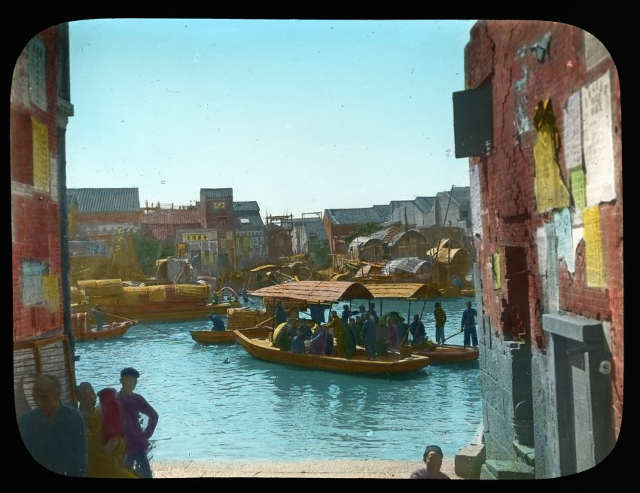
Downtown Transport, circa 1900. The water taxi sampans add to the crowded thoroughfares, whether land or water-based, of a bustling Chinese city. PMM# 127.15, Gift of Joanna Carver Colcord
Penobscot Marine Museum has teamed up with the Belfast Free Library to answer this year’s Camden Conference question: “Is This China’s Century”. The Camden Conference is an annual conference that fosters “informed discourse on world issues” and this year it runs from February 22-24, 2019. As a lead-up to the main event, the Camden Conference sponsors satellite events around the state of Maine. In December, PMM Curator Cipperly Good gave a talk to audiences at Belfast Free Library arguing that the Nineteenth Century was in fact China’s Century. Our second collaboration with the Library is an exhibit of color prints depicting Chinese daily life from the early 1900s. The exhibit is on view now until the end of February, 2019.
These prints made from color transparencies, provide a glimpse into the lives of the Chinese aboard watercraft, a means for fishing, transportation, and housing. By 1900, China had transitioned from a feudal agrarian economy that resisted foreign commerce to one that embraced the global economy of imports and exports. A society kept hidden by centralized government with strict laws against foreign visitation was now open to the overtly pointed lens of the camera.
So how did Maine and China interact in the Nineteenth Century? Penobscot Bay captains entered the China Trade in the 1840s. The First Opium War of 1844 opened up five treaty ports in China to foreign trade. The Second Opium War of 1858 cracked open more coastal treaty ports and the inland rivers. The sailing ship captains of Maine engaged in the trade until the first decade of the 1900s. The American sailing cargo ship trade failed as foreign steamships took control from the American Merchant Marine, which failed to make the transition to steam early enough to remain competitive.
Captain Brown acquired these color transparencies of Hong Kong and Mainland China and gave them to Joanna Carver Colcord. Joanna, born at sea and raised on her father’s merchant marine ships, came from a long line of Searsport sea captains. The family made three voyages to Hong Kong, in 1890, 1892, and 1899.
